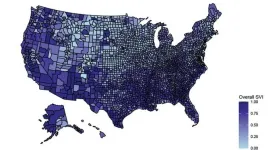(Press-News.org) PITTSBURGH, Jan. 29, 2021 - A study led by UPMC Children's Hospital of Pittsburgh and the University of Pittsburgh School of Medicine shows that Black children are 18% less likely to get imaging tests as part of their emergency department visit compared to White children. Hispanic children are 13% less likely to have imaging done than Whites.
The researchers suggest that this disparity results from overuse in White children, though underuse in minority children probably plays a part as well. The root cause likely stems from both patient preferences and implicit bias among providers.
"Something else is going on here that's beyond the clinical, that's beyond the diagnoses," said study lead author Jennifer Marin, M.D., M.Sc., associate professor of pediatrics, emergency medicine and radiology at Pitt, and medical director of point-of-care ultrasound at UPMC Children's Hospital. "Cultural factors that come with people's race, gender, religion, etc., should not be associated with testing when getting that test is clearly not beneficial to the patient and potentially harmful."
The study, published today in JAMA Network Open, used pediatric emergency department billing data from 52 hospitals across 27 states plus the District of Columbia from 2016 to 2019 to measure racial disparities across all types of diagnostic imaging. This is the largest, broadest study of its kind to date.
Even after controlling for confounding factors, such as health insurance, diagnosis and household income, the data showed that doctors were ordering significantly fewer imaging tests for Black and Hispanic children than for White children. The effect was even stronger among patients who weren't admitted to the hospital--suggesting they weren't severely injured or sick.
While the data cannot distinguish between a test that was warranted and a test that wasn't, prior research has shown examples of more frequent imaging in White children compared to other races, with no differences in clinical outcomes. The researchers suspect that the differences they see in testing are largely driven by unnecessary testing among Whites.
That's a concern because some forms of imaging, specifically CT scans and X-rays, expose children to radiation, which likely increases their cancer risk.
"An unnecessary CT at five years old is not the same as an unnecessary CT at 70 years old," Marin said. "If you think of it in terms of lifetime risk, a five-year-old has 80-ish years to go on and develop malignancy, versus a 70-year-old who only has 15 years."
False positives and waste in medical spending also are concerning when tests are being ordered unnecessarily.
"We may get an image and the radiologist may see something--and that something may not be of clinical significance--then the child has to be subjected to downstream testing and monitoring," Marin said. "That's an added burden and stress on the family and added cost on the health care system."
INFORMATION:
Additional authors on the study include Jonathan Rodean, M.P.P., and Matt Hall, Ph.D., of Children's Hospital Association; Elizabeth Alpern, M.D., M.S.C.E., of Ann & Robert H. Lurie Children's Hospital of Chicago and Northwestern University Feinberg School of Medicine; Paul Aronson, M.D., M.H.S., of Yale School of Medicine; Pradip Chaudhari, M.D., of Children's Hospital Los Angeles and Keck School of Medicine of the USC; Eyal Cohen, M.D., M.Sc., of the Hospital for Sick Children; Stephen Freedman, M.D.C.M., M.Sc., of Alberta Children's Hospital; Rustin Morse, M.D., M.M.M., of Nationwide Children's Hospital; Alon Peltz, M.D., M.B.A., of Harvard Medical School; Margaret Samuels-Kalow, M.D., M.Phil., M.S.H.P., of Massachusetts General Hospital; Samir Shah, M.D., M.S.C.E., of Cincinnati Children's Hospital Medical Center; Harold Simon, M.D., M.B.A., of Emory University School of Medicine; and Mark Neuman, M.D., M.P.H., of Boston Children's Hospital and Harvard Medical School.
Additional Contact:
Andrea Kunicky
Mobile: 412-552-7448
E-mail: KunickyA@upmc.edu
To read this release online or share it, visit http://www.upmc.com/media/news/012921-Marin-Imaging-Racial-Disparities [when embargo lifts].
About UPMC Children's Hospital of Pittsburgh
Regionally, nationally, and globally, UPMC Children's Hospital of Pittsburgh is a leader in the treatment of childhood conditions and diseases, a pioneer in the development of new and improved therapies, and a top educator of the next generation of pediatricians and pediatric subspecialists. With generous community support, UPMC Children's Hospital has fulfilled this mission since its founding in 1890. UPMC Children's is recognized consistently for its clinical, research, educational, and advocacy-related accomplishments, including ranking in the top 10 on the 2020-2021 U.S. News & World Report Honor Roll of America's Best Children's Hospitals. UPMC Children's also ranks 15th among children's hospitals and schools of medicine in funding for pediatric research provided by the National Institutes of Health (FY2019).
About the University of Pittsburgh School of Medicine
As one of the nation's leading academic centers for biomedical research, the University of Pittsburgh School of Medicine integrates advanced technology with basic science across a broad range of disciplines in a continuous quest to harness the power of new knowledge and improve the human condition. Driven mainly by the School of Medicine and its affiliates, Pitt has ranked among the top 10 recipients of funding from the National Institutes of Health since 1998. In rankings recently released by the National Science Foundation, Pitt ranked fifth among all American universities in total federal science and engineering research and development support.
Likewise, the School of Medicine is equally committed to advancing the quality and strength of its medical and graduate education programs, for which it is recognized as an innovative leader, and to training highly skilled, compassionate clinicians and creative scientists well-equipped to engage in world-class research. The School of Medicine is the academic partner of UPMC, which has collaborated with the University to raise the standard of medical excellence in Pittsburgh and to position health care as a driving force behind the region's economy. For more information about the School of Medicine, see http://www.medschool.pitt.edu.
http://www.upmc.com/media
In just one year, COVID-19 has killed more than 400,000 Americans, and infected more than 24 million others. But a new study shows just how unevenly those deaths and cases have played out across the country.
It finds that the more disadvantaged a county's population was before the pandemic, the higher the toll of coronavirus last spring and summer.
That level of disadvantage, measured on a standard scale called the Social Vulnerability Index (SVI), tracked closely with the number of cases and deaths per 100,000 residents in each county, according to the new University of Michigan study.
The ten-point SVI score combines many measures of the social disadvantage of a county's population, with higher scores meaning greater disadvantage. For every ...
What The Study Did: Maternally derived antibodies are a key element of neonatal immunity. This study examined the association between maternal and neonatal SARS-CoV-2-specific antibody concentrations because understanding the dynamics of maternal antibody responses to SARS-CoV-2 infection during pregnancy and subsequent transplacental antibody transfer can inform neonatal management as well as maternal vaccination strategies.
Authors: Scott E. Hensley, Ph.D., of the University of Pennsylvania in Philadelphia, and Karen M. Puopolo, M.D., Ph.D., of the Children's Hospital of Philadelphia, are the corresponding authors.
To ...
What The Study Did: Researchers investigated the association between county-level social risk factors and COVID-19 cases and deaths, as well as weekly changes in cumulative cases and mortality, using publicly available data sets as of July 29, 2020.
Authors: Renuka Tipirneni, M.D., M.Sc., of the University of Michigan in Ann Arbor, is th corresponding author.
To access the embargoed study: Visit our For The Media website at this link https://media.jamanetwork.com/
(doi:10.1001/jamanetworkopen.2020.36462)
Editor's Note: The article includes conflict of interest and funding/support disclosures. Please see the article ...
What The Study Did: This study investigated how unemployment insurance and a $600 per week federal supplement to unemployment insurance were associated with food insecurity among people in low- and middle-income households who lost jobs during the COVID-19 pandemic.
Authors: Julia Raifman, Sc.D., of the Boston University School of Public Health, is the corresponding author.
To access the embargoed study: Visit our For The Media website at this link https://media.jamanetwork.com/
(doi:10.1001/jamanetworkopen.2020.35884)
Editor's Note: The article includes conflict of interest and funding/support disclosures. Please see the article for additional information, including other authors, author contributions and affiliations, conflict ...
What The Study Did: Researchers examined if the use of diagnostic imaging for children receiving care in pediatric emergency departments in the United States differs by race and ethnicity.
Authors: Jennifer R. Marin, M.D., M.Sc., of the University of Pittsburgh School of Medicine, is the corresponding author.
To access the embargoed study: Visit our For The Media website at this link https://media.jamanetwork.com/
(doi:10.1001/jamanetworkopen.2020.33710)
Editor's Note: The article includes conflict of interest disclosures. Please see the article for additional information, including other authors, author contributions and affiliations, conflict of interest and financial disclosures, ...
Researchers at the University of Arizona are developing a COVID-19 testing method that uses a smartphone microscope to analyze saliva samples and deliver results in about 10 minutes.
The UArizona research team, led by biomedical engineering professor Jeong-Yeol Yoon, aims to combine the speed of existing nasal swab antigen tests with the high accuracy of nasal swab PCR, or polymerase chain reaction, tests. The researchers are adapting an inexpensive method that they originally created to detect norovirus - the microbe famous for spreading on cruise ships - using a smartphone microscope.
They plan to use the method in conjunction with a saline swish-gargle test developed by Michael Worobey, ...
Evidence is emerging that vitamin D - and possibly vitamins K and A - might help combat COVID-19. A new study from the University of Bristol published in the journal of the German Chemical Society Angewandte Chemie has shown how they - and other antiviral drugs - might work. The research indicates that these dietary supplements and compounds could bind to the viral spike protein and so might reduce SARS-CoV-2 infectivity. In contrast, cholesterol may increase infectivity, which could explain why having high cholesterol is considered a risk factor for serious ...
An international team of researchers led by Oxford Brookes University shows that black howler monkeys in Mexico not only remember where important events took place in their habitat, but also when to return to such locations.
The researchers recorded the behaviour of five groups of black howler monkeys accumulating over 3,000 hours of field observations at Palenque National Park, southern Mexico.
Expert fruit foragers
Black howler monkeys were observed navigating deliberately towards out of sight fruit trees that were ripening. Fruit is a desired food by many animals in rainforests so being able to anticipate when fruit is going to be available and where, is a great strategy to forage ahead of competitors. ...
This is the conclusion of a recent study by an international team of researchers, including Anne-Marie Elbe, Professor of Sports Psychology at Leipzig University. The finding is of social importance because experiences in adolescence in particular have a formative influence on attitudes and behaviour in later life.
In sport, football is considered a model of inclusion. "Remarkably, to the best of our knowledge, theory and research on feelings of inclusion in (youth) team sports is lacking," the authors write in their study. They add that filling this gap is important, because team sports are not necessarily inclusive by nature.
For ...
Using the developing eye of the fruit fly as a test platform, researchers found that RPS-12 protein overproduction appears to trigger triple-negative breast cancer and possibly some other malignancies. The protein indirectly switches on an important inracellular signaling pathway active while the embryo develops and shut down in healthy cells of adults. Far Eastern Federal University (FEFU), the University of Geneva, and the Institute of Protein Research (Russia) scientists addressed the problem in Scientific Reports.
Researchers have taken another step towards targeted treatment of tumors. The idea of such a therapy is to identify the necessary ...





